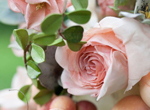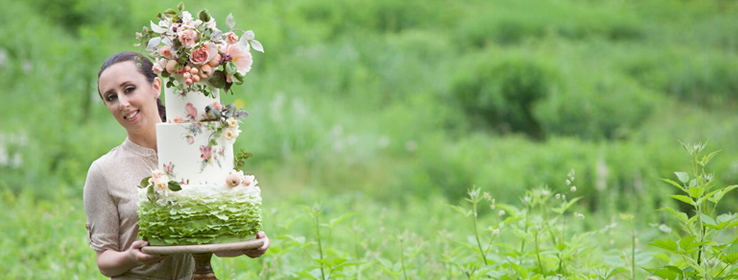Maggie Austin creates colorful cakes for royalty and Hollywood stars. Learn how she constructs her delicate artworks before they fall to the fork.
By Susan Dietrich
A career-ending injury left ballet dancer Maggie Austin with nothing to fall back on, so she took one more leap: pastry school. Following a stint at legendary Charlie Trotter’s in Chicago, a website showcasing her work went viral in 2010. Within two weeks, she was on NBC’s Today show.
Now, from a studio in Alexandria, Virginia, she accepts no more than two cake orders a month, at $8,000 minimum plus expenses. Austin can spend a week traveling across the world to personally deliver and set up each cake.
STIR: Pastry is a principal branch of architecture, according to Antonin Caréme, father of French cuisine. Your “bricks and mortar” are the cake tiers stacked on top of each other. What other materials do you use to create your magic?
Maggie Austin (MA): Sugar and color! My cakes, mostly wedding cakes, are draped with fondant, a sugar dough that’s
rolled out almost thinner than is possible. It’s a canvas only, not for flavor. To form flowers I use sugar gum paste, which dries permanently. Both can be colored or painted with FDA-approved food gels or powders, including metallics and glitter. There’s no limit to the spectrum or saturation. Flavor is another dimension, but for my purposes, it’s irrelevant to my color choices.

STIR: Where do you get your color inspiration?
MA: Mostly from clients, event planners and/or editors, but I push their imaginations so it’s not all matchy-matchy. Color is also about light. My sister and partner, Jessica Rapier, has an MFA in theater lighting design. We seriously consider the lighting for each event. We display cakes on stands and position them carefully so they float in the surrounding light. I keep the light in mind when mixing colors, too. Like paint, the colors change after they set up, but, unlike paint, they can continue to change over time and in varying temperatures and humidity. Experience is the only way to learn how to accommodate all those
variables.
STIR: It’s not surprising that a dancer would be all about movement, and you do animate your cakes with precariously placed flowers, overly extended vines and your signature layers of frills. How do you use color to accentuate this movement?
MA: I use flat color only for background. I heighten intense color with contrast colors. I just follow my instincts. I carve my own molds for unique shapes and textures that play with light and shadow. A single frill around a cake was nothing new, but I overlap lots of them up the side, often in gently ombréd hues. For my Tiffany lamp-style cakes I repeatedly layer on color and then remove some, even most, of it until it appears to glow from within.

STIR: Your clientele is international. How do different cultures use color to celebrate?
MA: Culture has a huge impact on color choice. In Japan, clients are drawn to softer pastels. By contrast, Indian weddings are an absolute riot of saturation.
STIR: You still have a dancer’s obsessive pursuit of perfection. What’s it like to be a prima pâtissière on a new stage?
MA: Part of the reason I love what I do is that I have the chance to participate in celebrations all over the world. But once everything is perfect with the cake, I make a graceful exit before anyone arrives.
This article originally ran in the 2016 STIR Print Annual issue.








